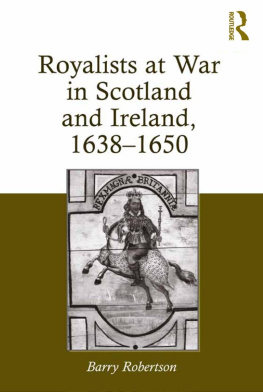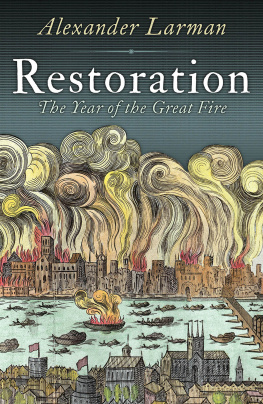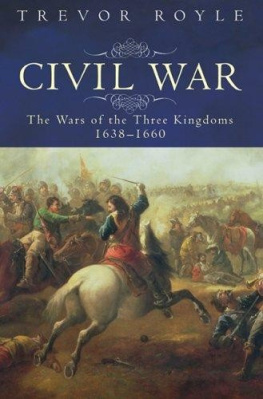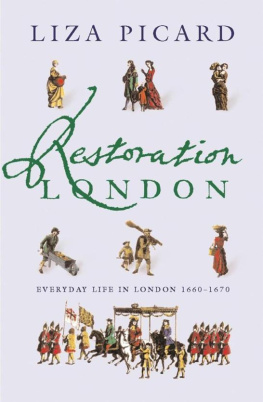PENGUIN BOOKS
RESTORATION
Tim Harris has spent much of his teaching life rethinking and re-imagining late Stuart Britain. His fascination with the growth of popular politics, mass journalism and crowds has been expressed in a number of groundbreaking books, including London Crowds in the Reign of Charles II and Politics under the Late Stuarts. He taught for some years at Emmanual College, Cambridge, but has since 1986 taught at Brown University, Rhode Island, where he is now Munro-Goodwin-Wilkinson Professor of European History.
TIM HARRIS
Restoration
Charles II and his Kingdoms
16601685

PENGUIN BOOKS
PENGUIN BOOKS
Published by the Penguin Group
Penguin Books Ltd, 80 Strand, London WC2R 0RL , England
Penguin Group (USA) Inc., 375 Hudson Street, New York, New York 10014, USA
Penguin Group (Canada), 90 Eglinton Avenue East, Suite 700, Toronto, Ontario, Canada M4P 2Y3 (a division of Pearson Penguin Canada Inc.)
Penguin Ireland, 25 St Stephen's Green, Dublin 2, Ireland (a division of Penguin Books Ltd)
Penguin Group (Australia), 250 Camberwell Road, Camberwell, Victoria 3124, Australia (a division of Pearson Australia Group Pty Ltd)
Penguin Books India Pvt Ltd, 11 Community Centre, Panchsheel Park, New Delhi 110 017, India
Penguin Group (NZ), cnr Airborne and Rosedale Roads, Albany, Auckland 1310, New Zealand (a division of Pearson New Zealand Ltd)
Penguin Books (South Africa) (Pty) Ltd, 24 Sturdee Avenue, Rosebank 2196, Johannesburg, South Africa
Penguin Books Ltd, Registered Offices: 80 Strand, London WC2R 0RL , England
www.penguin.com
First published by Allen Lane 2005
Published in Penguin Books 2006
Copyright Tim Harris, 2005
All rights reserved
The moral right of the author has been asserted
Frontispiece Popish Tyranny and Cruelty: Whig woodcut depicting alleged acts of Catholic cruelty against Protestants, and the Spanish Armada.
Except in the United States of America, this book is sold subject to the condition that it shall not, by way of trade or otherwise, be lent, re-sold, hired out, or otherwise circulated without the publisher's prior consent in any form of binding or cover other than that in which it is published and without a similar condition including this condition being imposed on the subsequent purchaser
ISBN: 978-0-14-192674-2
For Mark Goldie
Contents
List of Illustrations
Plate Section
Preface
This book has been a long time in the making. I was advised several years ago by my colleague Gordon Wood that I should take my time and write a big book. I took him at his word, and ended up producing something that was too big to be published as one, and so it has now become two (still quite big) books. What is on offer here is the first.
My original aim had been to write a book which picked up where my study of London Crowds in the Reign of Charles II (Cambridge, 1987) had left off (roughly towards the end of 1682) and carry the story through to the Glorious Revolution, but to make my account a national one rather than focused on just the capital. This would therefore have been a study of the Tory Reaction, the reign of James II and the Revolution of 16889, and would have combined high politics with low politics and attempted to answer the call I had made in the introduction to my Politics of Religion in Restoration England (Oxford, 1990 co-edited with Paul Seaward and Mark Goldie) for a social history of politics for this period. My project, I believed, would cause us fundamentally to rethink the 1680s and the nature of the Glorious Revolution an event which I felt had been mischaracterized as a mere dynastic coup imposed from above and outside, but which to me seemed more like a genuine revolution and one brought about from below. Several years ago one of my students at Brown, after recognizing the elitist bias in traditional secondary accounts of 16889, had poignantly raised the question in class: Where was the crowd? My desire was to write an account which would put the crowd back in, which would be people-focused as much as it was politician-focused, and which would recognize the vital contribution which those below the level of the elite made to the political history of this period, through either their sufferings or their activism. However, the study became international rather than national, as it soon became apparent that the story of Scotland and Ireland would need to be told as well. It therefore also grew in scope considerably so, as it turned out, since I was determined to do justice to the Scottish and Irish pasts for their own sakes, and not just bring them in for cameo appearances to help flesh out an Anglocentric narrative. In the process, the chronological boundaries of the book grew, to cover the years from 1660 to 1720, although with the focus remaining firmly on the 1680s.
It is important to be aware that the project has been conceived all along as an integrated whole. This influenced its organizational logic. The basic questions I sought to address were: how did a regime that had been so popular when it was restored in 1660 fall into crisis by 1680? how did it manage to recover from that crisis by 1685? and how did it sink back so dramatically into crisis by 1688 so that a reigning monarch could be toppled from his throne in England (Scotland and Ireland were very different stories) without being able to offer any significant resistance? The book, as originally conceived, was therefore divided into four parts: from Restoration to crisis, c. 166081; royal recovery under Charles II, c. 168185; the reign of James II, 16858; and the Revolutions and their outcomes, c. 16881720. Only after my editor at Penguin, Simon Winder, had read a complete draft of the whole was the decision taken to make it two bookswith the first two parts (on the reign of Charles II) forming book one, and the last two book two. I might have thought about the structure somewhat differently had I started with the intention of writing two separate books. There is not a great deal, for example, on Restoration politics in England, in part because this is a story that has been told by others already, and in part because, given the conception of the project as a whole, an analytical discussion of the problems facing the Restoration polity in England seemed a more compelling way of guiding the reader about what was going wrong at this time and why the regime was to fall into crisis by the late 1670s. Moreover, there are certainly things that are explained at length in this first book because they provide a vital context for understanding developments traced in book two. I began writing this book from 1685 onward; only when I had finished the chapters on the Revolutions did I go back and draft the chapters for the years 166085, with the aim of setting the context for what was to come thereafter. Nevertheless, in splitting the project into two I have made every effort to produce two stand-alone books ones which are self-sufficient in the sense that each can be read on its own and does not require familiarity with its companion volume to be intelligible.
Many will no doubt see this study as an exercise in the new British history. Problems nevertheless remain over the use of the adjective British to describe an integrated history of the three constituent kingdoms of the Stuart monarchy. Ireland was not part of Britain, in the literal geographical sense, since Britain was the island which comprised England, Scotland and Wales. It is true that Ireland was occasionally called West Britain or Lesser Britain, but that in itself was an imperialist usage, a view from the British mainland rather than an accurate geographical designation or a term used by the inhabitants of Ireland themselves. Politically, the island of Ireland as a whole was to be part of the British state for only a little over a century, between 1801 and 1922. Ethnically, the indigenous Irish population were Gaelic rather than British, although there were also many British peoples (English, Welsh and Scots) living in Ireland. On the other hand, there were also many non-British peoples living in Scotland and Wales. Strictly speaking, this study deals not with Britain nor with the British (exclusively), but with the various peoples who inhabited the Britannic archipelago in the North Atlantic off the coast of north-west Europe and who happened to be ruled over by the same monarch. Indeed, the style his Britannick majesty was frequently used by contemporaries to refer to either Charles II or James II in his capacity as king of England, Scotland and Ireland.
Next page











